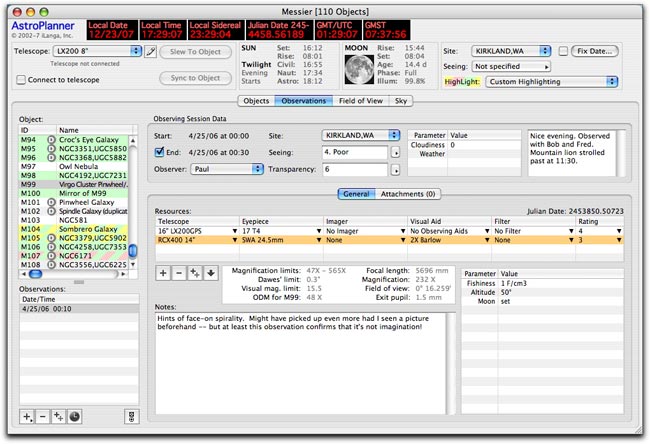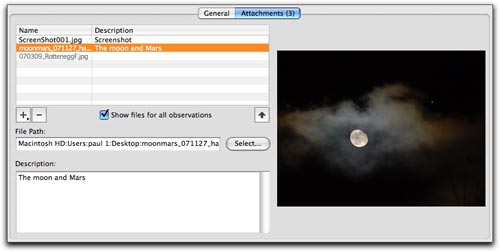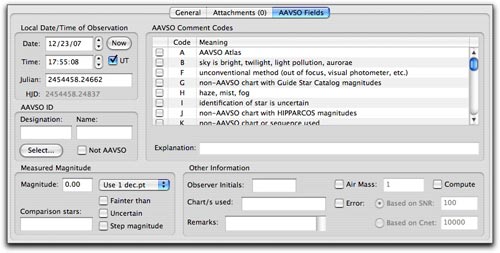Back to the plan document. Observations are now made on a separate Observations tab.

Lots of stuff to study here. The object list is carried through on the left. The observations shown in this tab are all associated with the selected object (M99 in this instance). All observations of the selected object are shown in the list at the bottom left.
New in V2 is the concept of an observing “session”. A session is associated with observations made on the same night at the same site. When you create your first observation of the night, it will automatically start a new session record (or let you continue an existing session where necessary). The session record includes data common to the observations being made, such as observer, site, atmospheric conditions, general notes, and includes user-defined parameters.
A generic observation, as shown above, contains references to resources used (e.g. telescope, eyepiece, etc.). However, you are no longer limited to one set. You can now, say, rate your observation through various eyepieces, etc. It will also compute and display information for the resources used (such as magnification, actual FOV, etc.).
Observations also have their own (unlimited) set of user-defined parameters. Lots of user-defined parameters in V2…
New in V2 is the ability to add attachments (as many as you like) to an observation. This feature is accessed via the Attachments tab.

You can attach any kind of file you like. AstroPlanner will attempt to display it if it can. Otherwise you can open the file in any applicable application. You can reference existing files wherever they reside, or you can add a copy of the file to a “database” that is kept by AstroPlanner.
For “specialised” observations, additional tabs will be added. For example, for AAVSO observations, the observation fields are added as an AAVSO Fields tab.

As you can imagine, this opens up a whole bunch of possibilities for other types of “specialised” observations in the future (e.g. double stars, lunar and planetary observations, imaging “observations”, radio telescopy observations, etc.)
Dave Adshead | 02-Jan-08 at 1:01 pm | Permalink
This is all exciting stuff and just what I want, plenty of space to add my thoughts and experiences and feelings. Wonderful.
Michael Morris | 12-Jan-08 at 3:22 am | Permalink
The new observing log section looks superb. In fact, everything I’ve seen so far about version 2 looks amazing. This will knock spots off your main competitors (Deepskyplanner and Skytools 2). My plan is transcribe all my observing notes, sketches and images on to Astroplanner. This is a long term project as I’ve got 4 years worth of stuff!
I can’t wait for the launch – but I guess I’ll have to!